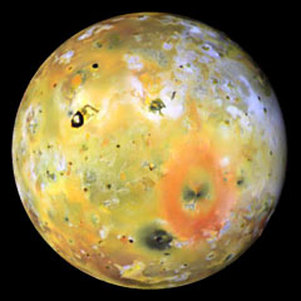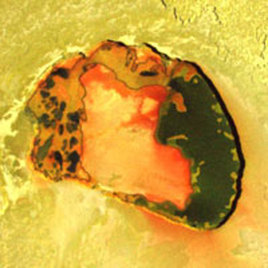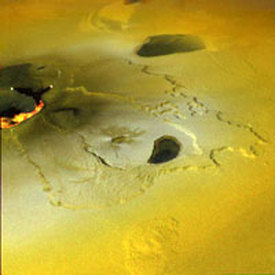Our Solar System
IO

IO is the most volcanically active body in the solar system with regular eruptions that constantly re-cover its surface. Slightly larger than Earth’s Moon, IO is Jupiter’s third largest satellite.
Io orbits closer to Jupiter's cloud tops than the moon does to Earth. This places Io within an intense radiation belt that bathes the satellite with energetic electrons, protons, and heavier ions. As the Jovian magnetosphere rotates, it sweeps past Io and strips away about 1,000 kilograms (1 ton) per second of volcanic gases and other materials. This produces a neutral cloud of atoms orbiting with Io as well as a huge, doughnut shaped torus of ions that glow in the ultraviolet. The torus's heavy ions migrate outward, and their pressure inflates the Jovian magnetosphere to more than twice its expected size. Some of the more energetic sulfur and oxygen ions fall along the magnetic field into the planet's atmosphere, resulting in auroras. Io acts as an electrical generator as it moves through Jupiter's magnetic field, developing 400,000 volts across its diameter and generating an electric current of 3 million amperes that flows along the magnetic field to the planet's ionosphere.
Io orbits closer to Jupiter's cloud tops than the moon does to Earth. This places Io within an intense radiation belt that bathes the satellite with energetic electrons, protons, and heavier ions. As the Jovian magnetosphere rotates, it sweeps past Io and strips away about 1,000 kilograms (1 ton) per second of volcanic gases and other materials. This produces a neutral cloud of atoms orbiting with Io as well as a huge, doughnut shaped torus of ions that glow in the ultraviolet. The torus's heavy ions migrate outward, and their pressure inflates the Jovian magnetosphere to more than twice its expected size. Some of the more energetic sulfur and oxygen ions fall along the magnetic field into the planet's atmosphere, resulting in auroras. Io acts as an electrical generator as it moves through Jupiter's magnetic field, developing 400,000 volts across its diameter and generating an electric current of 3 million amperes that flows along the magnetic field to the planet's ionosphere.
A Volcanic, Blistered World

Io is without a doubt the most bizarre-looking object to be discovered by the Voyager spacecraft. It is unlike any other moon in the Solar System. The surface of this moon is pockmarked with more colors than could have been imagined. Most of these features are believed to be formed by sulfur and sulfur compounds at different temperatures. Astronomers had expected to see impact craters when the first pictures came in from the Voyager probes. Instead, they were shocked to find that Io has almost no craters. The surface is extremely young, and is constantly reshaping itself. The most surprising discovery on the Voyager mission was that of active volcanoes on Io. Io's surface is littered with hundreds of volcanic calderas. Voyager sent back images of active volcanoes spewing sulfur hundreds of miles into space. Observations with the Hubble Space telescope are constantly turning up new volcanic eruptions. Io is the only body in the Solar System besides the Earth known to have active volcanoes
Features of IO

The surface of Io is covered by a number of strange features. It looks more like a pizza with "the works" than a moon. The most striking features are the volcanoes. Astronomers believe that Io is caught in a process known as "tidal pumping". It is constantly being pulled by Europa and Ganymede, and then pulled back in its orbit by Jupiter. This "tug-of-war" is literally pulling the planet inside out. This process distorts Io's surface by as much as 330 feet (100 meters). The friction caused by this process creates a lot of heat within the small moon. It is similar to the way a coat hanger heats up when it is bent back and forth. Other strange features of Io include lakes of molten sulfur, non-volcanic mountains, volcanic vents, and lava flows hundreds of miles long. The sulfur and various sulfuric compounds are responsible for the varying colors on Io's surface, giving it a mottled look. Astronomers once believed Io to be composed mainly of rocky material with very little iron. But recent discoveries by the Galileo probe show that Io has an enormous iron core that takes up nearly half its diameter. A newly discovered hole in Jupiter's magnetic field is leading astronomers to speculate that Io may have a magnetic field of its own. If so, it would be the first moon known to have one. Io also has a thin atmosphere of sulfur dioxide with traces of other gases. Unlike the other Galilean satellites, Io has almost no water.
Statistics for IO
Discovered by - Galileo Galilei & Simon Marius
Year of Discovery - 1610
Diameter - 2,264 miles (3,643 km)
Mean Distance from Jupiter - 262,094 miles (421,800 km)
Rotational Period - 1.76 days
Orbital Period - 1.76 days
Orbital Eccentricity - 0.004
Orbital Inclination - 0.04 degrees
Mean Surface Temperature - -243° F (-152° C)
Main Atmospheric Component - None
Apparent Magnitude - 5.02
Year of Discovery - 1610
Diameter - 2,264 miles (3,643 km)
Mean Distance from Jupiter - 262,094 miles (421,800 km)
Rotational Period - 1.76 days
Orbital Period - 1.76 days
Orbital Eccentricity - 0.004
Orbital Inclination - 0.04 degrees
Mean Surface Temperature - -243° F (-152° C)
Main Atmospheric Component - None
Apparent Magnitude - 5.02
